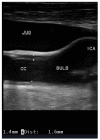Carotid Atherosclerosis, Ultrasound and Lipoproteins
- PMID: 34066616
- PMCID: PMC8148516
- DOI: 10.3390/biomedicines9050521
Carotid Atherosclerosis, Ultrasound and Lipoproteins
Abstract
Carotid artery plaques are considered a measure of atherosclerosis and are associated with an increased risk of atherosclerotic cardiovascular disease, particularly ischemic strokes. Monitoring of patients with an elevated risk of stroke is critical in developing better prevention strategies. Non-invasive imaging allows us to directly see atherosclerosis in vessels and many features that are related to plaque vulnerability. A large body of evidence has demonstrated a strong correlation between some lipid parameters and carotid atherosclerosis. In this article, we review the relationship between lipids and atherosclerosis with a focus on carotid ultrasound, the most common method to estimate atherosclerotic load.
Keywords: atherosclerosis; carotid ultrasound; lipids.
Conflict of interest statement
The authors declare no conflict of interest.
Figures
References
-
- Tonstad S., Joakimsen O., Stenland-Bugge E., Leren T.P., Ose L., Rusell D., Bonaa K.H. Risk factors related to carotid intima-media thickness and plaque in children with familial hypercholesterolemia and control subjects. Arterioscler. Thromb. Vasc. Biol. 1996;16:984–991. doi: 10.1161/01.ATV.16.8.984. - DOI - PubMed
Publication types
LinkOut - more resources
Full Text Sources


